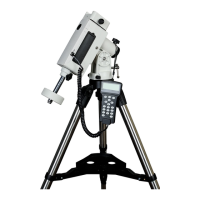21
one star alignment should be sufficient for good GOTO accuracy. To increase the accuracy you may
choose to do two star alignment.
5.5.2. Two Star Alignment
Two star alignment will increase the GOTO accuracy of the mount. Two star alignment requires a
wider view of the sky, since the two align stars need to be far apart. Press MENU button and select “Align”.
Select “Two Star Align” in the align menu. A list of alignment stars that are above the horizon is computed
based on your local time and location. With the mount is at the “Zero Position,” use ▲ and ▼ buttons to
select first alignment star and press ENTER. Center the target in your eyepiece using arrow key. Press
ENTER when finished. The hand controller will prompt you to choose the second star. If the star you choose
is too close to the first one, the system will let you choose another one. When you are aligned with the
second star, the two star alignment is finished. You can reject the suggested star if it is blocked by a tree or
other obstruction.
After the two-star alignment, a pointing error between the R.A. axis and the polar axis will be
recorded. This number can be used to fine tune the R.A. axis.
5.5.3. Three Star Alignment
Three-star alignment procedure will reduce the so-called “cone error” of an EQ mount. Every
mount’s accuracy of construction varies somewhat, so the optical axis of the telescope may not be
perpendicular to the declination axis or, more rarely, the polar axis may not be at right angles to the
declination axis. These small errors (known collectively as the cone error) can make a big difference to the
GOTO performance of your mount, so it pays to understand the implications.
From the main menu select “Align”. Select “Three Star Align”. Hand controller will then present you
with the name of a suggested alignment star. If this star is blocked by a tree or building, press the down
arrow to advance through the list in alphabetical order until you find a star that is visible. Press ENTER and
the mount will slew to where it thinks the star you have selected lies, beeping once it has finished moving.
Most likely, the scope won’t be pointing exactly at the star, so use the up, down, left or right arrows to centre
the star — first in the finder, then in the eyepiece. Once you are done, press ENTER and the next alignment
star will be selected. Repeat this process until you have selected all three stars. For a better result, select
three stars located in the different part of the sky.
5.5.4. Disp R.A Axis Error
This displays the celestial pole pointing error after two star alignment. When the HC shows for
example:
Altitude: 02º30" lower
Azimuth: 01º13" east,
It means the polar axis of the mount is pointing lower and to the east.
5.5.5. Pole Star Position
This shows Polaris position in northern hemisphere or Sigma Octantis position in southern
hemisphere.
5.6. Set User Objects
Besides various star lists available in the hand controller --you can add, edit or delete your own user-
defined objects. You can also add your favorite observation object into the user object list for easy sky
surfing. Up to 60 user objects can be stored here.

